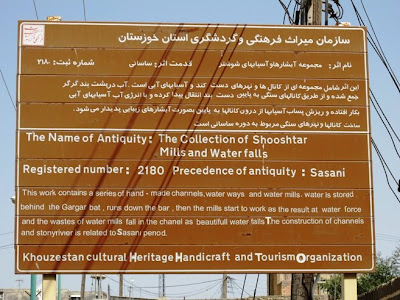As Salaam,
Friday, April 29th, @ 10.00hrs...leaving Abadan city just after breakfast, we began the second day of our Khuzestan tour in a convoy of a four-bus-ride to Shushtar, a journey of more than 200 km northward. About halfway we passed through the provincial capital of Ahwaz (about 90km away from Shushtar) and stopped at Molla Sany's Ramin Agricultural University compound for a short rest and reception.
Three hours later, we finally reached our destination, Shushtar city. After a sumptuous lunch at Mostowfi House, we also had the opportunity to explore the historical building and its beautiful garden and surrounding, used to belong to one of the richest merchants of the city named Agha Khalil Mostowfi during the Qajar era.
The afternoon session was primarily spent on a visit to the city's main attraction, the Shushtar historical hydro structures and later on westward to the ancient complex of Chogha Zanbil.
Shushtar town stands on a cliff to the west of which runs the river Karoon. The river's middle course begins a few kilometers north, providing considerable commercial and strategic importance, and hence made it possible for the construction of various waterworks for which the town has long been well-known. The famous watermills of Shushtar can be traced back to the period of Darius the Great in the 5th century BC. The Shushtar watermills are indeed the samples of ancient architectural and technical skills of the city and of ancient Persia.
Located some 45 kilometres southeast of the ancient city of Shush or Susa, Chogha Zanbil Ziggurat, which literally means 'basket mound,' is the only remnant art of the ancient city of about 1300 BC, and the most important remnant of the Elamite civilization. Built on a plateau above the banks of river Dez, the complex was also known by its antique name of Dur Untash, which means castle or the city of Untash, founded by King Untash in the 13th century BC. The city and the works belonged to the Elamite civilization in Haft Tape in 640 BC. Its size and splendour was intended to honour the gods and to manifest the power of King Untash Napirisha.
Made of mainly mud bricks and occsionally baked bricks, the monuments were well built and beautifully decorated with glazed baked bricks, gypsum, ornaments of fayence and glass. Chogha Zanbil complex is one of UNESCO's registered World Heritage sites in Iran, and its ziggurat is considered to be the best preserved example of temple tower in the world.
When we left Chogha Zanbil, it was almost sunset and hence had to cancel our visit to Haft Tape, another archeological site and the remains of the 15th century BC ancient city of Kabnak in the province.
Wassalam.
 rows of date plantation along the way...
rows of date plantation along the way...  unwinding @ Ramin Agricultural University...
unwinding @ Ramin Agricultural University...  red bougainvillea...
red bougainvillea...  and red berries...
and red berries...  mini apple...
mini apple...  shrine of Imamzadeh Abdullah, Shushtar
shrine of Imamzadeh Abdullah, Shushtar  a Qajar era wealthy merchant house...
a Qajar era wealthy merchant house...  named Agha Khalil Mostowfi...
named Agha Khalil Mostowfi...  sumptuous lunch @ the city's historical complex...
sumptuous lunch @ the city's historical complex... view of Shushtar from Mostowfi House...
view of Shushtar from Mostowfi House... 



















No comments:
Post a Comment